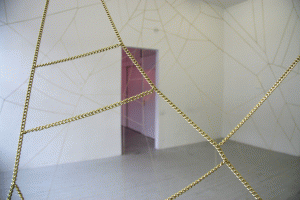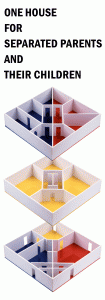« Features
From Solid to Liquid / Interview with Anja Ciupka
From 2000 on, German artist Anja Ciupka has developed a semi-figurative formal language in her installations, sculptures, videos, and paper. Her experimental approach takes an ironic look at the perception of the human being in society and often plays with the subversive occupation of space. I met Anja Ciupka (1975, Zwickau, lives and works in Düsseldorf) two years ago during her solo exhibition at Kunstverein Arnsberg after winning the competition for young artists. For her project Passionate Single, Anja Ciupka conceived an ensemble of sculptures, drawings and video works, which were not easy to classify, i.e., neither as a “site specific sculpture” nor “conceptual video.” What makes Ciupka‘s work so interesting is the multi-layered focus by which she analyzes in a consistent manner the diverse social and political changes in contemporary German society; her most recent show “Diadem” at the Hamburg Gallery Galerie Katharina Bittel is a clear example.
By Necmi Sönmez
Necmi Sönmez - In your exhibitions one could perceive a certain “setting” using several media and techniques simultaneously (sculpture, video and drawing). The setting oriented itself towards the power of interpretation on the part of the viewer and determined different strategies that all deal with private experience and the perception of the space. How did you develop these strategies?
Anja Ciupka - That is a difficult question, because I don’t think that as an artist one develops strategies on a purely calculating, logical level, which are then resolved by the viewer. The development of a concept is a complex process in which a combination of different factors plays a role: emotions, imagination, reflection, observation, experience, previous works and new projects. For example, for my show at the Kunstverein Arnsberg, I have played with the title “Passionate Single,” drawn into the floor plans of the Kunstverein, have consolidated my settings, thought up stories and finally created an overall concept that is for me conclusive.
N. S. - The transformative power of your sculptures focuses the exhibition space as an “artistic medium.” The goal of your installation projects as in Kunsthalle Düsseldorf or Kunstverein Arnsberg can be interpreted as a way to move from a clearly defined spatial perception to an indeterminate, imaginary situation, in order to refer to something left. How do you look at and interpret exhibition space?
A. C. - Besides many other factors, the exhibition space is one aspect in the complex process of developing my works. Although I am not interested in exclusively site-specific work, I always explore the site-specific conditions of the exhibition space as one important starting point. This includes on the one hand the formal aspects of a place, like architecture, materials, light, shape and size of the rooms. On the other hand, I also reflect on the contextual situation of a place; I am interested in its business, users and the future audience of my work. My approach might be similar to what Nicolas Bourriaud described as “Relational Art.” Although I am mostly starting with personal observation, I am trying to bring to my work a general point of view about human relations and their social context. Therefore, the coordinates which describe a room and its delineation play an important role in my work.
BETWEEN FICTION AND REALITY
N.S - With your installation Skooter, you’ve changed the exhibition space into a fairground ride. Your works and interventions deal enigmatically with the grey area between fiction and reality.
A. C. - Yes, in my installation Skooter, two bumper cars are placed on the shiny grey floor of the exhibition hall. Their trolley poles are connected to a section of grating larger than 120 square meters, which is stretched between aluminum frames. This space is only defined by the grating suspended from the ceiling and the position of the two bumper cars. The dodgems’ illuminated headlights signal their readiness. The temptation to jump into the cars and drive around is very strong. But is it merely possible or just a suggestion? These moments of unsettling temptation and uncertainty are precisely the point I’d like to reach. These elaborate deceptions circle around narratives and possible outcomes - the truth or indeed the function of which remains concealed.
N. S. - When entering the exhibition space at Katharina Bittel Gallery, the visitor is impressed by an enormous four-meter high, six-meter long and three-meter deep complex asymmetrical netting made out of thin gold chains. At first glance all of your works make a strong, direct impact and function as autonomous art works. What is the formal design of your work about?
A. C. - Each work has an inner logic for me, which includes perfection and precision with regard to the formal medium used. The appearance of a work is never a means in itself for me; however, it is important because form and content are inseparably interconnected. At the same time I succeed - by means of the formal language - in carrying the work into an area that leads away from a purely symbolic, explicit readability. For me, it is important that each work make a direct impact on the viewers, regardless of how much previous knowledge they have of art history. The works are intended to have a sustained ambivalent effect, to confront and at the same time enthuse, to unsettle and to validate.
SOCIAL RELATIONSHIPS AND LIQUID MODERNITY
N. S. - At the same time your artistic ideas reflect social relations, especially in contemporary German society. How do you focus on social relationships?
A. C. - Yes, besides site-specific conditions, I am including a critical examination of personal experiences and an awareness of contemporary social phenomena and current affairs, while thinking about new works. The spider net at Galerie Katharina Bittel is not only a formal structure; it is inspired by a spider on drugs, in this case caffeine. Experiments have shown that spiders spin their webs irregularly when they have been given drugs. The maximization of the performance causes a collapse, maybe because of wanting something too much or including unconscious, yet self-induced, mistakes. The spider’s web as a trap to catch prey fails in its function. There are various possible interpretations. You may read it as a humorous reference to networking in the art world or as an ironic symbol in the search for a partner.
N. S. - In your exhibition in Kunstverein Arnsberg, you exhibited three drawings - showing footprints of different living situations - titled Passionate Single, Professional Artist and Solid Order. With Solid Order, you used a term taken from Zygmunt Bauman’s publication Liquid Modernity. To what extent does the text Flüchtige Moderne (fleeting Modernism) play a role in your work?
A. C. - In Flüchtige Moderne, Zygmunt Bauman describes how the “solid order” was disposed of, with the intention of constructing a new, improved order. However, human life was, above all, increasingly dominated by economic measures. One consequence of this was the dismantlement of social connections in favor of human freedom of action. New models of society, which allow for these developments, seldom materialize. Zygmunt Bauman uses the terms “Flüssigkeit” (fluidity) and “Flüchtigkeit” (fleetingness) as metaphors to describe what is specific to the present as we know it.
My work focuses on making these multifaceted influences on our current living situation tangible and on at least providing impulses for new models (like trials). Each design incorporates the notion of a counter-design. My statements are intended to be dialectic, open, fluid, provocative and conciliatory all at the same time. I don’t think that we will find the ideal model, but, by means of flexible thought and action, we can at least confront our situation reflectively and move towards finding solutions.
N. S. - With Passionate Single or your 3m-high graphic design poster One house for Separated Parents, you focused on rigorous isolation as one of your central themes. Your focus on separation has developed from a greater interest in concrete social development and the functioning of the social and personal level. Is this also the case in your recent works and projects?
A. C. - Yes, similar to my early proposal One House for Separated Parents and their Children, the exhibition at Galerie Katharina Bittel includes my new suggestion: Single Mother by Choice. It appears as a graphic 1.5m-high and 1.10m-wide proposal written on the wall. It is carried out in red neon light, which depicts the handwriting and gives the sign a warm and lively appearance. This is a loose and humorous reference to the spider net in the opposite room. The form of the golden spider net is inspired by a diadem spider (also called cross or garden spider). The diadem spider often kills and eats the male spider after copulation. Diadem spiders are single mothers by nature. This is a topic that is increasingly present in today’s society, but may not be regarded as the “perfect model.” However, the claim for self-determination and self-realization, as well as the possibility of feeding oneself and a family also without a man (because the “happy end” may have not appeared yet), are topics that women increasingly discuss.
Necmi Sönmez is an independent curator based in Düsseldorf. His current activities include co-curating the exhibition “Unexpected” Kunstmuseum Bochum, serving as a member of the Committee of Experts (Comité Technique) of the Regional Contemporary Art Fund (FRAC) in the French region of Franche-Comté and working as advisor for the Borusan Corporate Collection in Istanbul.





































